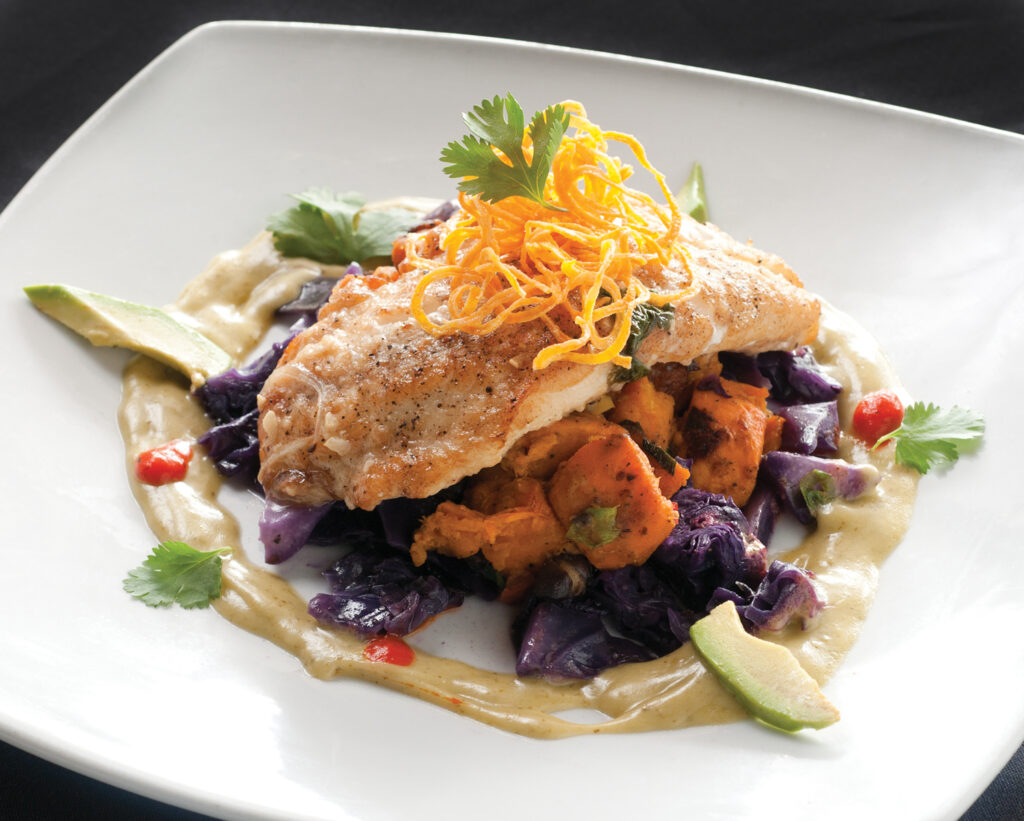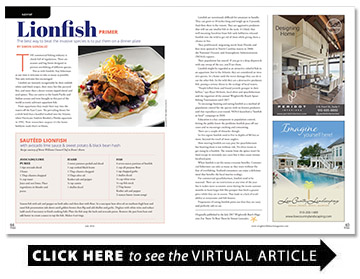Lionfish Primer
The best way to beat the invasive species is to put them on a dinner plate
BY Simon Gonzalez

The commercial fishing industry is chock-full of regulations. There are seasons and bag limits designed to prevent overfishing of different species.
Not so with lionfish. Any fisherman at any time is welcome to take as many as possible. Not only welcome but encouraged.
Lionfish are instantly recognizable by their reddish white-and-black stripes, their wavy fan-like pectoral fins, and more than a dozen venom-tipped dorsal and anal spines. They are native to the South Pacific and Indian oceans and were brought to this part of the world as exotic saltwater aquarium fish.
From aquariums they made their way into the waters off the East Coast. The prevailing theory for a while held that a handful washed into the Atlantic when Hurricane Andrew flooded a Florida aquarium in 1992. Now researchers suspect it’s the home hobbyist trade that’s to blame.
Lionfish are notoriously difficult for amateurs to handle. They can grow to 18 inches long and weigh up to 3 pounds. And then there is the venom. They are aggressive predators that will eat any smaller fish in the tank. It’s likely that well-meaning Sunshine State fish tank hobbyists released lionfish into the wild to get rid of them while giving them a chance to live.
They proliferated, migrating north from Florida and first were spotted in North Carolina waters in 2000, the National Oceanic and Atmospheric Administration (NOAA) reports.
Their population has soared. If you go in a deep shipwreck with any sweep of the eye, you’ll see them.
Lionfish might be regarded as an attractive colorful fish in an aquarium, but in the Atlantic they are considered an invasive species. In a home tank the worst damage they can do is eat the other fish. In the wild they are a destructive predatory fish, posing a serious threat to the ecology of local waters.
“People killed them and found juvenile grouper in their bellies,” says Ryan McInnis, local diver and spearfisherman and the organizer of the annual Wrightsville Beach Spearfishing Tournament until 2017.
To encourage hunting and eating lionfish as a method of population control for the species with no known predators and that reproduces year-round, NOAA launched a “lionfish as food” campaign in 2010.
Education is a key component to population control, letting the public know the problems lionfish pose off our coast and to encourage catching and consuming.
There are a couple of obstacles though.
In this region lionfish tend to live in depths of 80 feet or more, beyond the reach of most anglers.
Slow-moving lionfish are easy prey for spearfishermen but hunting them is not without risk. No diver wants to get stung by a lionfish. The venom from the spines won’t be fatal except in extremely rare cases but it does cause intense localized pain.
When lionfish is on the menu everyone benefits. Commercial fishermen can take as many as they want without the fear of overfishing. Seafood consumers can enjoy a delicious meal that benefits the local marine ecology.
For commercial spearfishermen, lionfish tend to be seasonal. There are no restrictions at any time of the year but it makes more economic sense during the warm summer months to hunt larger fish like grouper that fetch a greater price while they are in season. That leads to a lack of availability at restaurants and fish houses.
Proponents of eating lionfish point out that they are tasty and perfectly safe to eat.
Originally published in the July 2017 Wrightsville Beach Magazine, Eat Them To Beat Them by Simon Gonzalez.
Sautéed Lionfish
With avocado lime sauce & sweet potato & black bean hash
Recipe courtesy of Brent Williams Owner/Chef at Brent’s Bistro
AVOCADO/LIME PUREE
- 1 ripe avocado diced
- 2 limes
- 1 Tbsp cilantro chopped
- ¼ cup water
Juice and zest limes. Place ingredients in blender and puree.
HASH
- 2 sweet potatoes peeled and diced
- 1 cup cooked black beans
- 1 Tbsp cilantro chopped
- 3 Tbsps olive oil
- Kosher salt and pepper
- ¼ tsp cumin
- 1 shallot diced
FISH
- 4 seven-ounce portions of lionfish
- 1 cup all-purpose flour
- 1 tsp chopped garlic
- 1 shallot diced
- ½ cup white wine
- ½ cup fish stock
- 2 Tbsp butter
- Kosher salt and pepper
- 2 ounces butter (room temp)
Season fish with salt and pepper on both sides and then dust with flour. In a saucepan heat olive oil on medium-high heat and sauté fish presentation side down until golden-brown then flip and add shallot and garlic. Deglaze with white wine and reduce (add stock if necessary to finish cooking fish). Plate the fish atop the hash and avocado puree. Remove the pan from heat and add butter to create a sauce to top the fish. Makes 4 servings.
